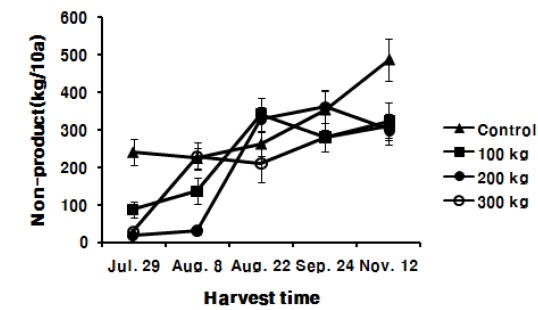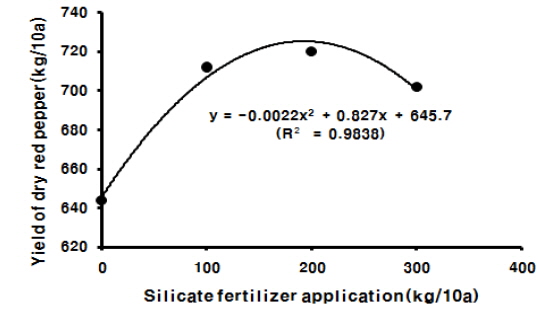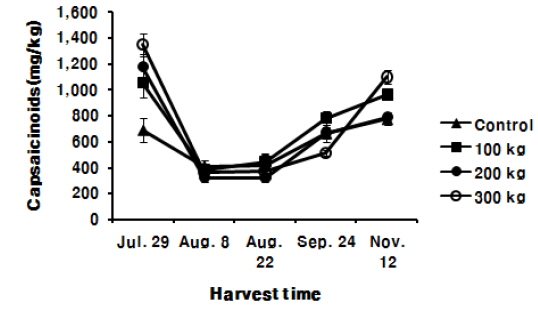



This study was conducted to investigate effects of silicate fertilizer application on red pepper (
The silicate fertilizer was applied as 0, 100, 200, and 300 kg/10a as basal dressing before transplanting pepper plant seedlings. Cultivar of the pepper plant was Cheon-Ha-Dae-Se. Amounts of inorganic fertilizer applied as N-P2O5-K2O=19.0-6.4-10.1kg/10a was estimated depending on soil test values. After applying 50% of nitrogen, 100% of phosphorus, and 60% of potassium fertilizers as basal dressing, the seedlings of pepper plant were transplanted. The rests of nitrogen and potassium fertilizers were applied as side-dressing after the first, second, and fourth harvests of red pepper. When comparing selected chemical properties of soils between before transplanting and after final(the fifth) harvest, soil pH, available P2O5, and exchangeable Ca2+ increased with increasing the applications of silicate fertilizer, whereas electrical conductivity(EC) decreased. However, exchangeable K+ was higher with the treatments of 100 and 200 kg/10a, and exchangeable Mg2+ was higher with 300 kg/10a application. In addition, nitrogen and phosphorus concentrations of red pepper collected from the first harvesting stage decreased with increasing the applications of silicate fertilizer, but potassium, calcium, and magnesium concentrations in red pepper were highest with 300 kg/10a application. Yield of red pepper increased between 9.0 and 11.8% with the applications of silicate fertilizer. Marketable fruit rate of res pepper was highest(97.3%) with 200 kg/10a application.
The application of silicate fertilizer as basal dressing in paddy-converted fields improved soil chemistry and increased red pepper productivity.
규소는 기초 광물을 형성하는 요소로서 지각이나 토양을 구성하는 화학성분 중 산소에 이어 28%를 차지하는 성분이며, 벼를 포함한 각종 작물 생육에 필수적이라는 사실이 1920년대 미국 캘리포니아대학에서 처음 발견되었으나(Sommer, 1926), 국내에서는 1957년부터 논에 규산질비료가 공급되기 시작했다(Joo and Lee, 2011). 정부에서 제공하는 규산질비료는 1970년대 후반부터 천연규회석에서 광재를 이용하여 제조한 비료로 교체되기 시작하였으며, 현재는 입상, 분상, 사상의 형태로 규산질비료가 공급되고 있다.
규소는 화본과작물에 필요한 물질로 수량을 크게 증대시키며(Epstein, 1994), 쌀 품질과 저장성을 향상시키고(Won
카네이션과 칼랑코 재배시 규산질비료를 사용한 결과 뿌리의 생체중, 건물중 그리고 엽 두께 등이 증가하였고(Bae
식물 필수원소에 포함되지는 않지만 규소를 처리하여 재배한 식물은 각종 스트레스에 대한 저항성이 커지고, 식물의 직립성을 높여 광합성 효율을 증진시킨다(Ma 2004). 또한 양분 흡수를 도와 식물생육을 촉진하는 효과가 있고, 토양중 전질소 함량을 크게 증가시키고, 인산활용도를 높이고, 질소의 흡수 이용률을 증진시켜 질소시비량을 저감할 수 있다(Lee
이와 같이 규소가 함유되어 있는 각종 규산질비료는 화본과 작물뿐만 아니라 원예작물 재배지의 토양 비옥도를 개선하고, 작물생육 촉진 및 병해충 방제 효과가 있었지만(Lee
규산질비료가 고추비가림 시설재배지 토양에 미치는 영향을 조사하기 위해 전북 임실군 지사면 안하리 1287-3번지(E127.21.14.01, N35.35.42.55) 고추 재배 농가의 시설 하우스에서 천하대세(동부팜흥농) 품종을 육묘하여 2013년 4월 10일 정식하였다. 재식밀도는 고추 시설재배의 경우 임실고추연구소에서 권장하는 120 × 45 cm 간격을 따랐다.
규산질비료 처리는 토양중 유효규산함량, pH 및 유기물함량 등이 규산질비료 유효화에 영향을 미치는 주요 토양특성인 점을 고려하여 0, 100, 200, 300 kg/10a를 경운전에 토양처리 하였으며, 사용한 규산질비료는 입상규산질(풍농, 규산 25∼28%, 고토 2∼3%, 알칼리분 40∼45%)이었다. 퇴비와 밑거름은 토양검정에 의한 시비기준(N-P2O5-K2O=19.0-6.4-10.1 kg/10a)에 따라 P2O5는 전량, N는 시비기준량의 50%, K2O는 시비기준량의 60%를 밑거름으로 시비하였고, 웃거름은 N 과 K2O 잔량을 3회로 나누어 고추 1, 2, 4차 수확 후에 관주에 의해 시비하였다. 각 처리구는 단구제로 배치하였고, 크기는 165 m2였다. 물 관리와 웃거름시비를 위해 점적관수시설을 설치하여 수행하였다.
토양은 시험전과 최종 수확기(5차)에 auger를 이용하여 처리구별로 3반복으로 채취하였고, 채취한 토양은 실험실에서 풍건하고 2 mm체를 통과한 것을 국립농업과학원의 토양화학 분석법(NAAS, 2010)과 토양 및 식물체 분석법(농촌진흥청 농업과학기술원, 2000)에 따라 실시하였다. 토성은 micro pipette법으로 분석하였으며, 판정은 미국농무부 분류기준을 따랐다(Gee and Bauder, 1986). 토양 화학성 조사는 pH와 Electrical Conductivity(EC)는 풍건토양과 증류수를 1:5(w/v)로 혼합하고 30분 진탕 후 pH meter(ORION 3 star, Thermo Scientific, Singapore)와 EC meter(ORION STAR A212, Thermo Scientific, Singapore)로 각각 측정하였다. 유기물 함량은 Tyurin법, 유효인산은 Lancaster법, 치환성 양이온(K+, Ca2+, Mg2+, Na+)은 1 N CH3COONH4(pH 7.0)으로 치환 추출하여 원자흡광분광광도계(Atomic Absorption Spectrophotometer, Avanta, GBC Scientific Equiment Pty Ltd., Victoria, Australia)를 이용하여 분석하였다. Cation exchange capacity(CEC)는 Ammonium acetate법, 유효규산은 1 M NaOAc 완충용액으로 추출하여 700 nm에서 비색정량 하였다.
식물체시료는 매 수확기마다 홍고추를 채취하였고, 잎은 1차 수확기(7월 29일)에 채취하여 증류수로 세척 후 70℃에서 72시간 건조 후 분쇄기(Pulverisette 5, Fritsch GmbH, Germany)로 분쇄하여 분석용 시료로 사용하였다. 전질소함량은 CN 원소분석기(Vario MAX CN, Elementar Analysensysteme GmbH, Germany)을 사용하여 분석하였다. 식물체 시료를 흑연블록 산순환포집분해장치(Ecopre, OD-lab, Seoul, Korea)를 이용하여 전처리하고, 인산은 ammonium vanadate법에 의한 비색정량, K, Ca, Mg는 원자흡광분광광도계(Atomic Absorption Spectrophotometer, GBC Avanta, GBC Scientific Equipment Pty Ltd, Victoria, Australia)을 이용하여 분석하였고, S는 원소분석기(CNS-2000, LECO Co., ST. Joseph, USA)를 사용하여 분석하였으며, Si는 중량법으로 측정하였다.
고추 지상부 생육조사는 정식 이후 처리별로 각각 30주씩을 선정하여 초장, 경경(줄기 직경)과 절수를 정식 후 30일 간격으로 2회(5월 10일, 6월 11일) 실시하였다. 경경은 지상부 2 cm 높이를 측정하였다. 고추 수량은 5회(7월 29일, 8월 8일, 8월 22일, 9월 24일, 11월 8일)에 걸쳐 수확하면서 생체중과 비상품과 등을 조사하였다. 병해충 피해를 받은 고추와 길이가 3 cm 이하인 과를 비상품과로 하였다.
고추 품질을 평가하기 위해 조사한 신미도는 capsaicin과 dihydrocapsaicin을 조사하였는데 건고추 시료 1 g을 50 mL tube에 취한 후 methanol 5 mL를 가하고 60℃ 항온수조에서 145 rpm으로 10분 동안 추출하였다. 추출액과 methanol을 1:9(v/v)비율로 희석하여 여과(0.2 um)하였다. 분석은HPLC(High-Pressure Liquid Chromatography, Alliance 2695 System, Waters Co. Milford, USA )를 이용하여 분석 하였고, 분석 조건은 Table 1과 같다. 이때 표준용액은 Sigma-Aldrich 제품을 사용하였다.
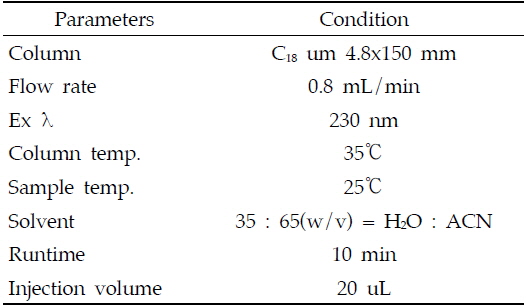
Analytical conditions of High-Pressure Liquid Chromatography(HPLC) for determining capsaicinoids
통계분석 조사한 자료의 통계분석은 SPSS(19.0K)를 사용하여 실시하였다.
고추를 재배한 토양은 주로 곡간지에 분포하는 회곡통으로 그동안 논으로 사용하다가 시설하우스로 전환한지 2년된 곳으로, 토양의 물리화학적 특성은 Table 2와 같다. 토성은 모래 40.1%, 미사 32.1%, 점토 27.8%인 양토였으며, 화학성은 농촌진흥청에서 제시하는 고추재배지 적정범위(작물별 시비처방기준, 국립농업과학원, 2010, pH 6.0∼6.5, OM(Organic Matter) 25∼30 g/kg, Avail. P2O5 450∼550 mg/kg, Exch.-K+ 0.70∼0.80 cmolc/kg, -Ca2+ 5.0∼6.0 cmolc/kg, -Mg2+ 1.5∼2.0 cmolc/kg, CEC 10∼15 cmolc/kg, EC 2 dS/m 이하) 보다 pH, 유효인산, 치환성 양이온 농도가 낮은 수준이었다.

Selected physical and chemical properties of soils in the experimental field before transplanting pepper plant seedlings
수확기 토양특성 변화를 조사하기 위해 2013년 11월 8일 5번째 고추를 수확하면서 토양을 채취하여 분석하였다(Table 3).

Changes of soil chemical properties in final harvesting time of red pepper(Capsicum annuum L.) as influenced by applications of silicate fertilizer
수확기 토양 pH는 무처리구의 경우 정식전보다 감소하였지만, 규산질비료 처리구는 처리량에 따라 증가하는 경향을 보였고, EC는 무처리구에서 정식전보다 증가하였지만, 규산질비료 처리구는 처리량이 적을수록 낮아졌다. Cho 등(2004)도 규산질비료 시비량에 따라 pH가 증가하였고, 규산질비료 100 kg/10a 처리로 pH를 0.1∼0.2 단위로 증가시킬 수 있다고 하였다. Joo 와 Lee(2011)의 연구에서도 규산질비료 시비량이 증가할수록 토양 pH는 증가하였는데, 이는 규산질비료에 함유되어 있는 Ca2+과 Mg2+과 같은 염기성 양이온이 토양용액내로 용해되고 또한 규산염이 일부 토양용액에서 가수분해 되어 pH가 상승된다고 하였다. 본 연구에서도 치환성 Ca2+이 규산질비료량과 비례관계를 보였지만, 치환성 Mg2+은 변화가 없었다. 그러나 치환성 Na+은 다소 증가하는 경향을 보였다. Lee 등(2003)의 연구에서도 규산질비료 처리구에서 치환성 Ca2+과 Mg2+ 함량이 증가하는 경향이었지만 통계적인 유의성은 없었다고 하였다. 농경지를 답전윤환 하였을때 석회질비료 대신 규산질비료를 사용하여 시설재배지의 토양 pH를 개선할 수 있을 것이다. 하지만 시설재배지에서 pH가 적정범위 이상으로 유지되면 인산흡수가 억제되거나 암모니아 가스 발생 우려가 있어 필요이상으로 pH를 증가시키지 않도록 규산질비료를 사용해야 할 것이다.
토양유기물 함량은 100 kg/10a 처리구에서 29 g/kg으로 가장 많았으며, 유효인산은 규산질비료 처리량과 비례관계를 보였다. 유효인산 함량증가는 규산질비료 시용에 따라 토양 pH가 개선되고, 유효규산함량이 무처리(124 mg/kg)에 비해 2.6∼3.5배 증가가 직접적인 영향인 것으로 판단된다. Suehisa 등(1963)도 규산질비료가 토양중 인산가용화를 촉진하고 잎에서 증산을 감소시켜 수분 손실을 줄여 준다고 하였다.
시험전 토양 중 유효인산함량이 133 mg/kg 수준에서 고추재배에 적정한 범위(450∼550 mg/kg)에 맞추기 위해 토양검정에 의한 시비가 이루어졌어도 수확기 토양 중 유효인산함량은 139∼171 mg/kg으로 정식 전에 비해 3∼38 mg/kg이 토양에 잔류하였고, 재배기간 동안 인산결핍장애등이 나타나지 않아 밑거름으로 시비한 인산질비료를 충분히 활용하였다고 판단된다. 하지만 규산질비료가 과다할 경우 인산흡수를 방해하여 생육을 저해할 수도 있어 밭작물에 대한 시비기준이 만들어져 농가에 보급되어야 할 것이다.
토양 중 유효규산함량은 규산질비료 처리량과 비례관계를 보였다. 규산과 인산은 서로 경쟁관계에 있어 유효인산함량이 낮은 토양의 경우 규산질비료의 유효화가 상대적으로 높아진다(Cho
고추시설재배지에서 규산질비료를 사용함에 따라 토양비옥도가 개선되고, 염류집적은 나타나지 않아 다른 시설원예작물 재배시에도 규산질비료를 활용할 수 있을 것으로 판단되지만, 사용량에 대해서는 작물에 따라 검토가 이루어져야 한다고 본다.
고추 정식 후 30일(5월 10일)과 60일(6월 9일)에 규산질비료 처리에 따른 생육상황을 비교하기 위해 초장, 줄기직경, 절수를 조사하였다(Table 4). 초장은 정식 30일 조사에서 차이가 없었지만, 60일 조사에서는 무처리와 200 kg/10a 처리구에서 같은 수준을 보였다. 표토로부터 2 cm 높이에서 측정한 줄기직경은 30일의 경우 무처리에서 낮았지만, 60일에서는 규산질비료 처리간에 차이가 없었다. 절수는 30일의 경우 무처리와 200 kg/10a 처리구가 많았지만, 60일의 경우 100 kg/10a 처리구가 가장 적었다. 따라서 정식 60일 까지는 무처리와 200 kg/10a 처리구에서 같은 수준을 보여 규산질비료가 지상부 생육에 크게 영향을 미치지 않는 것으로 판단된다.

Growth of red pepper(Capsicum annuum L.) plant as affected by applications of silicate fertilizer
시험기간 동안 홍고추를 5차에 걸쳐 수확하였는데, 1차 수확을 하면서 가장 최근에 성숙한 잎을 채취하여 무기성분 함량을 조사하였다(Table 5). N과 P는 규산질비료 처리량이 증가할수록 감소하는 결과를 보였고, K, Ca, Mg은 규산질비료 300 kg/10a 처리구에서 가장 많았고, 무처리에서 가장 낮은 수준을 보였다. 이는 규산질비료가 N, P와는 길항작용, K, Ca, Mg과는 상조작용을 한다는 것을 알 수 있다. 한편 S와 Si는 규산질비료 처리간에 차이가 없었다. 그러나 고추잎이 아닌 식물체 전체로 본다면 규산처리량 증가에 따른 수량증대로 인산흡수량이 증가할 것이다(Lee and Kim, 2006). Lee 등(2003)은 참외 잎에서 규산질비료 시용에 따라 인산과 규산이 증가하여 본 연구와 상반된 결과를 보였다. 따라서 인산과 규산은 작물에 의한 흡수과정에서 경쟁관계인지 아닌지 검토가 필요하다.

Selected nutrient contents in leaves of red pepper(Capsicum annuum L.) as influenced by applications of silicate fertilizer
한편 작물별 규소함량은 화본과작물의 경우 건물량으로 10∼15%, 곡류작물 1∼3%, 쌍자엽식물은 0.5% 함유하고 있는데(Vorm, 1980), 본 연구에서는 규산질비료 처리구에서 0.96∼1.00% 수준을 보였다.
홍고추 수확을 5차례 실시하면서 수확시기별로 조사한 수량은 후기로 갈수록 감소하였다(Fig. 1). 1차(July 29)와 3차(August 22) 수확기에는 처리간에 차이가 없었지만, 2차(August 8)와 4차(September 24) 수확기에는 규산질비료 처리구가 대조구보다 수량은 많았지만 규산질비료처리량에 따른 수량변화는 없었고, 5차 수확기에는 300 kg/10a 처리구에서 수량이 가장 많았다.
수확시기가 후반으로 갈수록 비상품과 수량은 증가하는 경향을 보였고, 대조구 증가폭이 가장 컸다(Fig. 2). 초기 수확기 비상품과 수량은 규산질비료 200 kg/10a 처리구에서 가장 낮았지만, 후기로 갈수록 규산질비료 처리량과 반비례관계를 보여 규산질비료가 고추품질을 향상시키는 것으로 나타났다.
규산질비료 처리에 따른 홍고추 수량특성은 Table 6에서 보는 바와 같이 대조구에 비해 수량은 9∼11.8% 증가하였다. 특히 규산질비료 200 kg/10a 수준으로 처리했을 때 가장 높았다. 홍고추 총 수량은 300 kg/10a 처리구에서 가장 많았지만, 200 kg/10a 처리구에서 비상품과 105 kg/10a 으로 가장 낮았고, 상품과율 97.3%로 가장 높았던 결과이다. 한편 대조구에서 상품과율이 가장 낮았고, 규산질비료 처리량에 따라 상품과율이 증가하였다.

Parameters to evaluate red pepper(Capsicum annuum L.) productivity as influenced by applications of silicate fertilizer
규산질비료 시비량과 고추 수량과의 관계는 Fig. 3에서 보는 바와 같이 Y=-.0022X2+0.827X+645.7(R2=0.9838)의 관계식을 얻었다. 이 회귀곡선식에 따른 최고 수량을 얻을 수 있는 규산질비료 시비량은 187.9 kg/10a이고, 수량은 723.4 kg/10a 이었다. Kwak 등(2001)에 따르면 작물재배에 적절한 질소시비량을 산출하기 위해서는 최고수량보다 경제적인 이윤을 고려한 시비가 이루어져야 하는데, 경제적인 적정시비량은 최고 수량의 95% 수준에 해당하는 시비량이라 할 수 있다. 비록 질소는 아니지만 본 연구에서 최고 수량의 95% 수준(687.2 kg/10a)을 얻을 수 있는 규산질비료 시비량은 59.7 kg/10a 으로 계산되었다.
따라서 시설재배지에서 고추재배시 규산질비료를 밑거름으로 사용하면 토양 pH가 개선되고 집적되는 염류량은 감소하였고, 비상품과 수량은 감소하여 생산량이 증가한 결과를 보여, 논토양에 시비하도록 공급된 규산질비료를 여러 가지 이유로 사용하지 않고 방치하고 있는 경우에 이를 시설재배지에 활용함으로써 토양화학성을 개선하고 자원을 효율적으로 활용할 수 있을 것으로 본다.
수확시기별로 채취한 고추 과의 capsaicinoids 함량은 capsaicin과 dihydrocapsaicin의 합계로 조사하였다(Fig. 4). 1차에 수확한 고추의 capsaicinoids 함량은 규산질비료 처리량과 비례관계를 보였지만, 3차와 4차에는 100 kg/10a 처리구에서 높았고, 다시 5차에는 300 kg/10a 처리구에서 높았다. 수확시기별로 홍고추 수량과 비슷한 경향을 보였고, 수확시기에 따라 큰 차이가 있었다. Cho 등(2004)의 연구에서도 고추 수확시기에 따라 capsaicinoids 함량 차이가 크다고 하였다. 그러나 Table 7에서 보는 바와 같이 1∼5차까지 조사한 신미도 함량의 평균값을 비교해보면 capsaicin 404.7∼516.9 mg/kg, dihydrocapsaicin 162.9∼194.4 mg/kg, capsaicinoids 590.7∼705.1 mg/kg으로 처리간에 통계적인 차이가 없었다. Capsaicinoids는 환경스트레스나, 품종 등에 의해 영향을 크게 받고 정도차이가 크다고 하였다(Harvell and Bosland, 1997; Bosland, 1996).
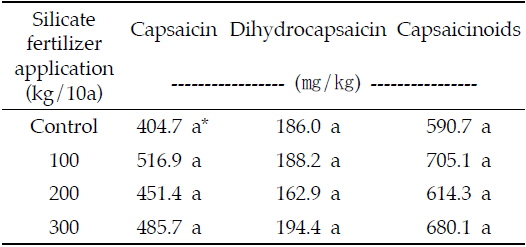
Changes in the concentrations of capsaicinoids in red pepper(Capsicum annuum L.) as influenced by applications of silicate fertilizer






